A WOODLEY FAMILY THROUGH AND THROUGH: THE EVANS FAMILY
The present Phillip Evans, with his wife Diane reside in Barkham. Although having inherited his father’s name, in truth Phillip senior always preferred to be call Phil. Fortunately ,it is the result of this lovely couple and their wealth of documents and photographs, that the family’s roots in Woodley can be traced back to the 1840s; in doing so making their story an ideal reflection on such a small community that lasted for over a century and a half.
The Evans family home for many decades was Headley Cottages, a block of five, located at the eastern extremity of Headley Road, on the northern side where Tippings Lane was joined. Surprisingly, for such a rural district as Woodley was in the late Victorian era, the cottage stood in a small yet fairly dense area of housing, in what was the southern border of the village centre, known from the 1850s as Cobblers City.
Our first encounter with the family is John, who is recorded as being the village blacksmith as far back in time as 1847.
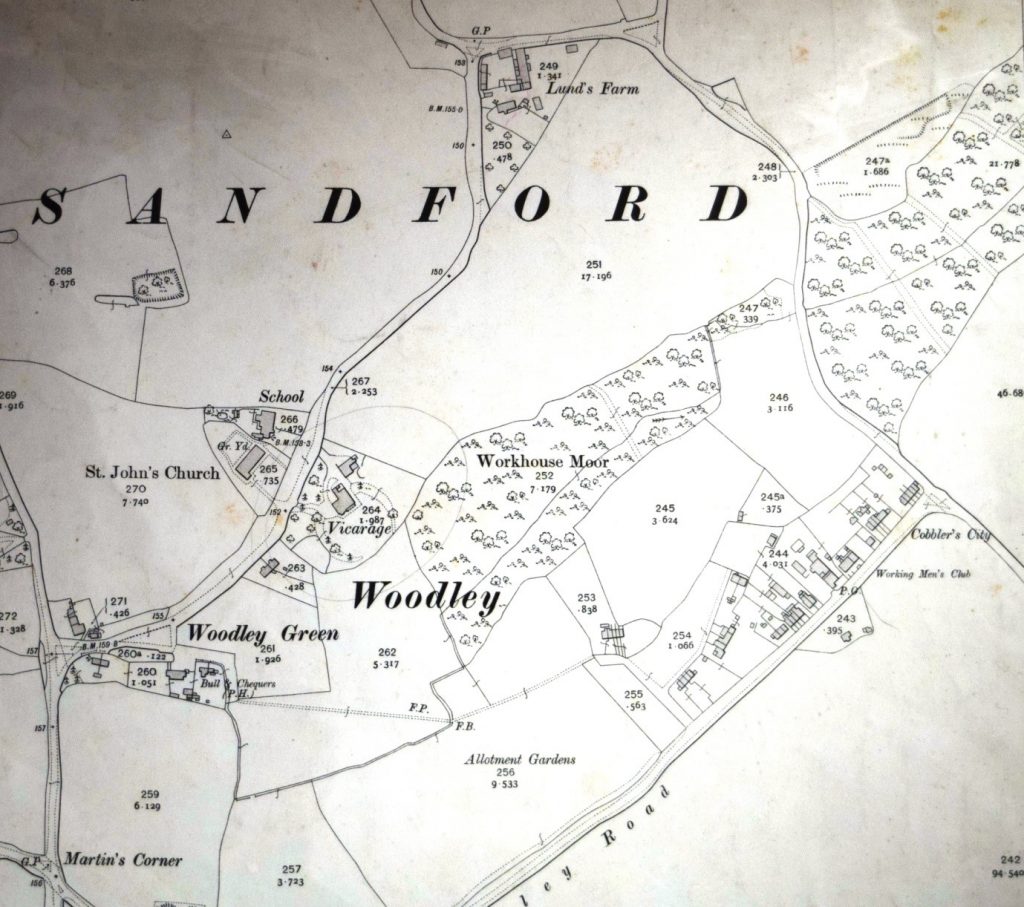
Illustration 1. Map of east Woodley with the village centred in and around the Bull and Chequers public house and St Johns Church etc. Clearly shown to the south of what was Workhouse Moor was Cobblers City, with Headley Cottages at the eastern extremity.
Illustration 2. Headley Cottages. Circa early 1920s with Horace Evans sitting on the ladder, and presumably his mother Emily Matilda. Horace was born on 23rd July 1899, fortunately just three months after the wedding in April. There then followed another son named Hubert.
Headley Cottages were owned by carpenter John Chandler in the mid 19th century.
As for the cottages, of which this appears to be the second from the western end of the block, kitchens were eventually fitted. Sadly the building was demolished in 1963. Today, in their place, are ubiquitous, featureless, grey industrial units that stretch the length of the Headley East Road.
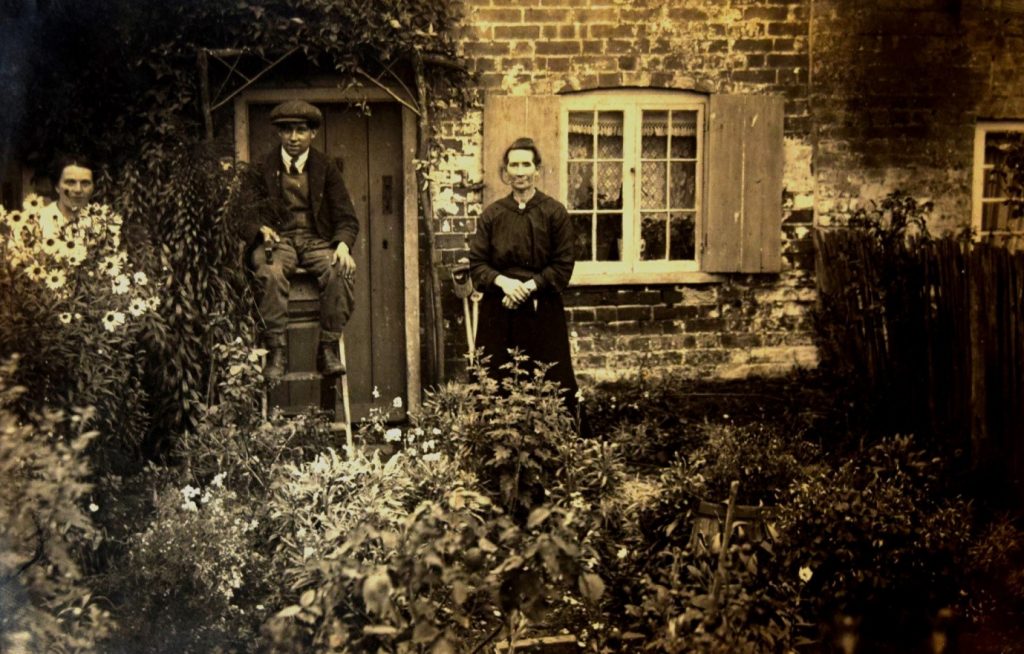
By the middle 1800s, and following the Land Enclosures that ended the free use of common land for grazing etc. local people were now no longer obliged to be working for their landed masters. Likewise the landed gentry no longer felt such a strong bond with their former employees. And so it was that with the growth of Industry in nearby Reading, culminating with the biscuit factory, and the railways, to name just two examples, that the local population looked further afield for a better standard of employment and income. Not to be left out according to the 1851 census was the Evans family, with Henry (senior) listed as married to a local girl, Matilda. As for his employment, it was as a ganger on the Great Western Railway.
Illustration 2a & 2b. Following the end of Brunel’s 7ft. 1/4in broad gauge in 1892, Sonning Cutting, along with the line as far west as Didcot, was widened to take four standard gauge lines: In doing so requiring the cutting to be widened, resulting in substantial retaining walls at the western end to prevent land slippages. In conjunction with the works was the opening of Sonning Cutting signal box (a) and the adjacent Duffield bridge (b). Both of which are pictured in 1894. Photos, Courtesy of Phillip and Diane Evans.
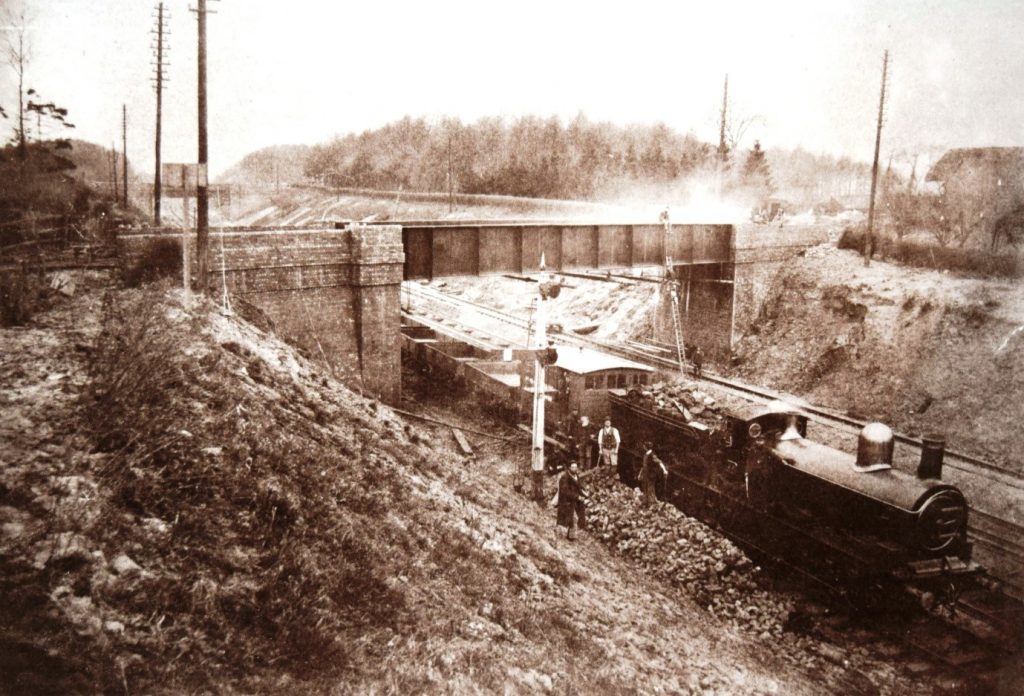
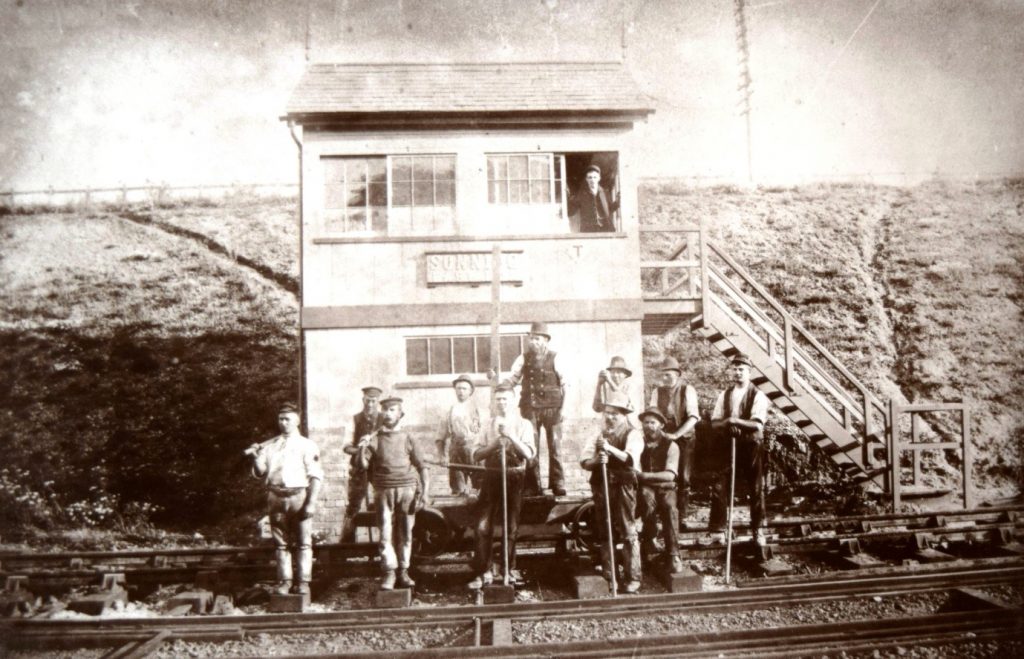
In the 1891 census we find that Henry’s two sons William and Henry (Jnr.) are also gainfully employed on the widening of the Great Western Railway in Sonning Cutting. As for the 1911 census, Sara Ann is recorded as being 62 years of age. Their 27 year old son Hubert was a household decorator, still living at home.
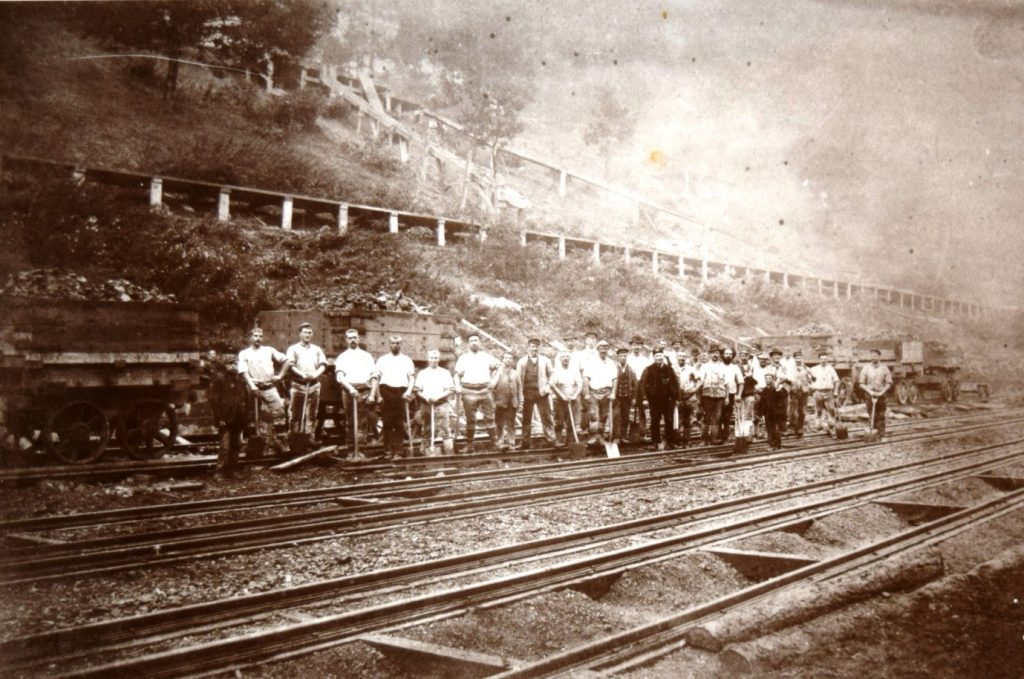
Two further illustrations of the widening of Sonning Cutting. Above. A fine body of navies pose for the camera. To the right is, a “Gin Run,” for taking the soil up the near vertical side.
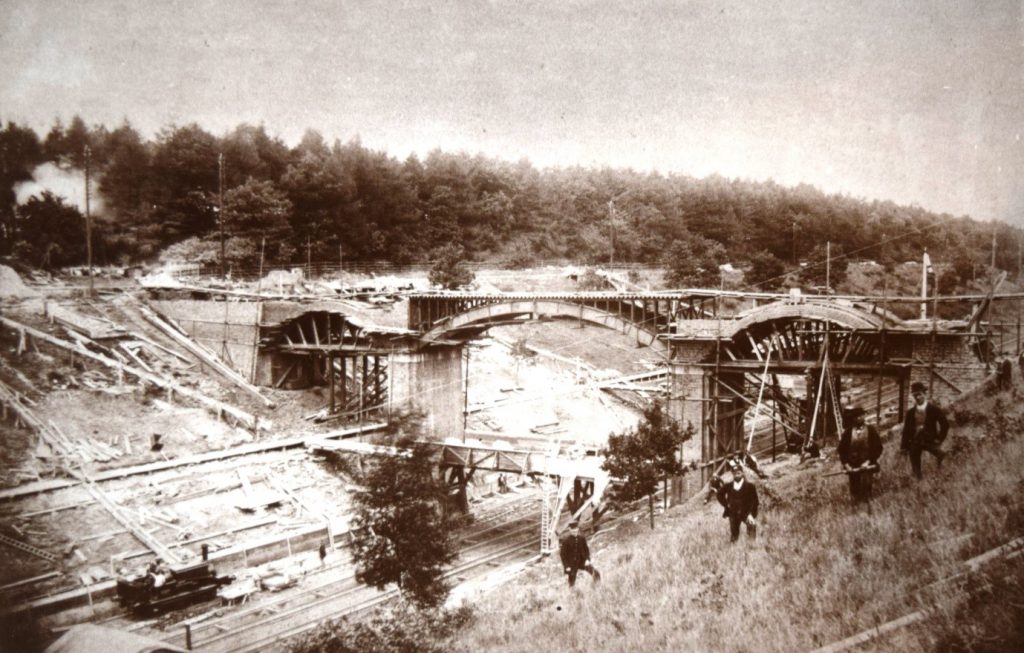
Above. Brunel’s wooden bridge in Warren Road, in the throes of being replaced with the much larger iron example that still stands today.
Illustration 3. To have survived for over a century, the Bill and receipt of payment, for the funeral of Henry (senior) is remarkable. As for a local builder performing the subtle task of undertaker and all of the associated arrangements, is quite unique. Perhaps this was an expedient due to the shortage of manpower and materials for undertakers due to the, in 1917, seemingly endless conflict.
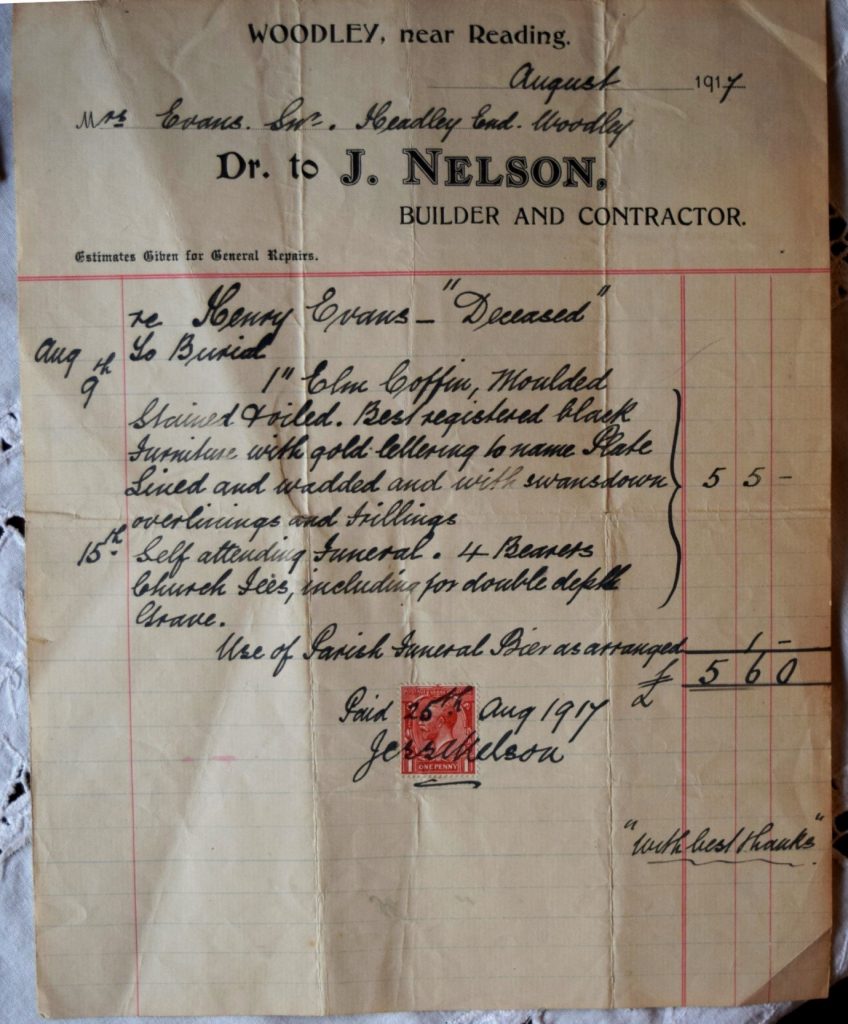
J. Nelson is listed in the local directory for 1916 as a builder and undertaker, which was an unusual pairing to say the least. Furthermore no address, both on the receipt and in the directory, is given other than Woodley. No doubt, so small was the local population to the postman and others that an address and house number was not considered to be of any worth.
Illustration 4. Horace appears to have been a lad of great diligence, as witnessed on the inside front page of a book presented to him at St. Johns Church in 1912, in recognition of a whole year’s Regular & Punctual Attendance at the Monday evening Choir practice at St John’s Church, dated June 12th 1911 – June 10th 1912.
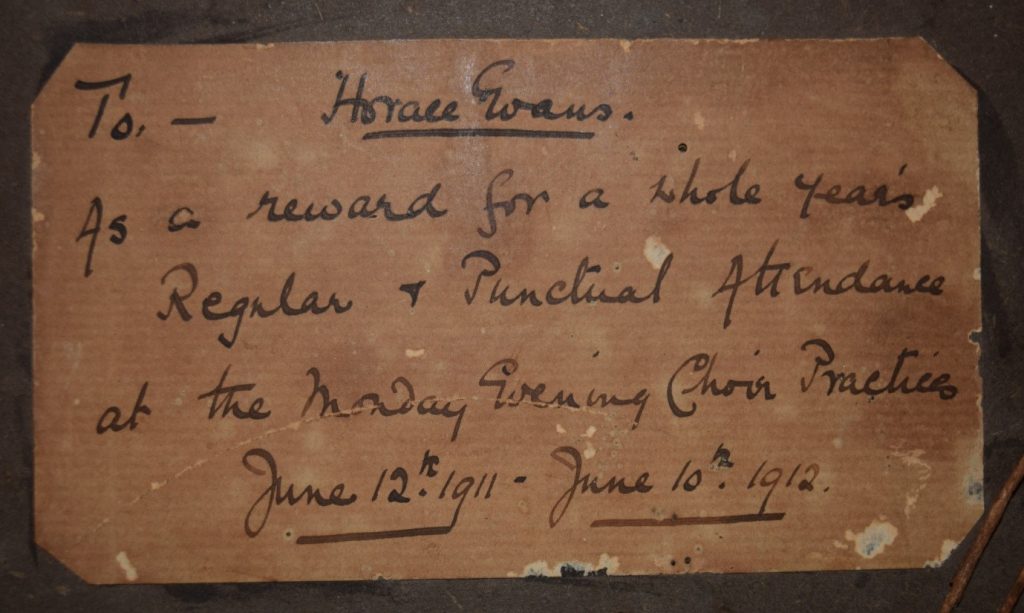
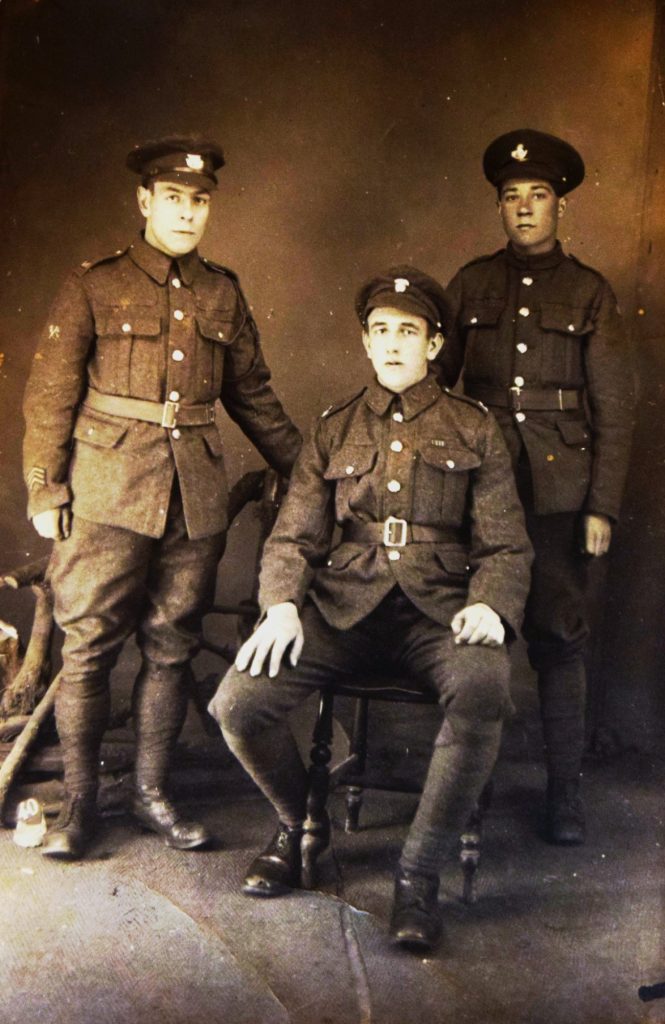
Illustration 5. Pictured during the Great War, looking like a mere child, Horace is to the right of the trio.
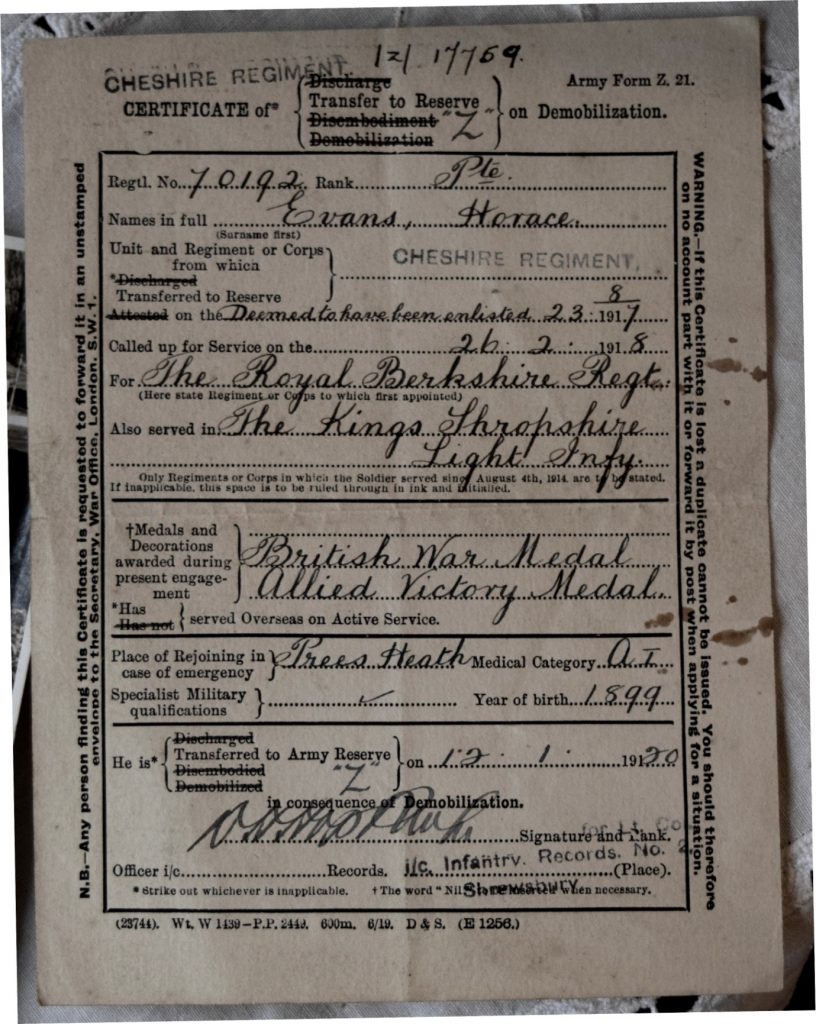
Illustration 6. By good fortune Horace Evans returned home in good health; having joined up as a mere seventeen year old lad in August 1917.
Illustration 7. Horace – The oldest man in Woodley. Reading Post. 16th March 1994.
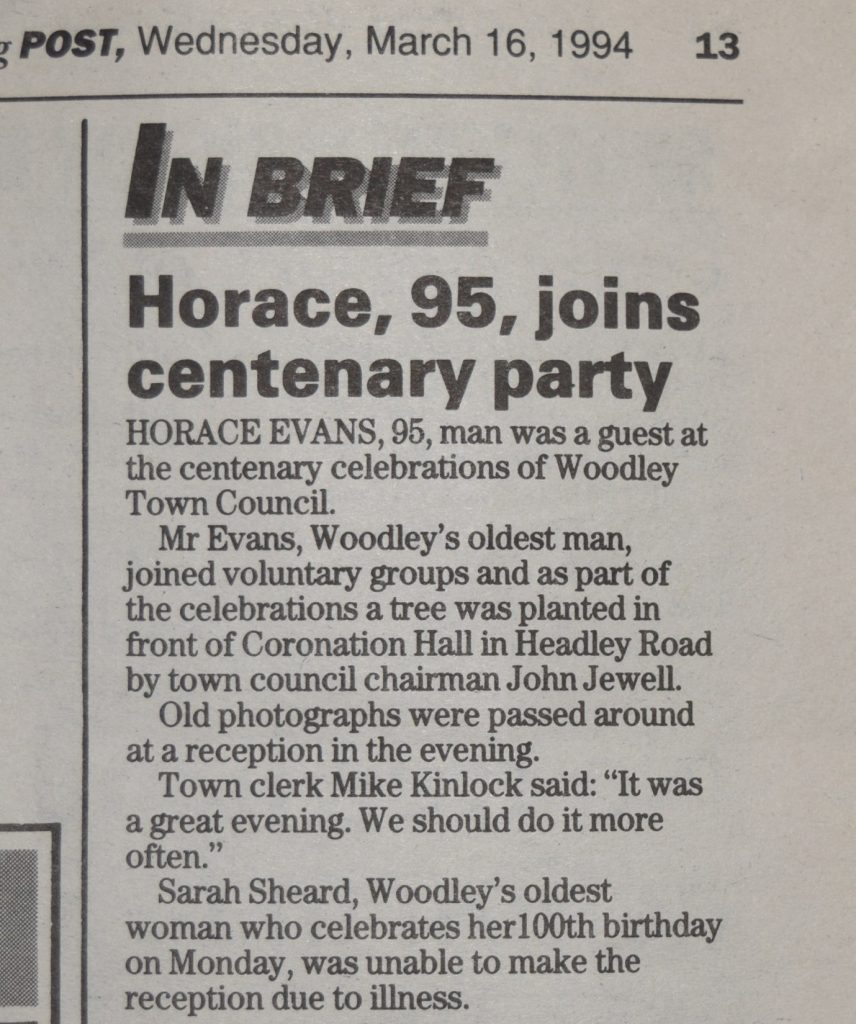
Phil’ (as he liked to be called) Evans was Phillip’s father. As for his mother, she came to Reading seeking employment. There being precious little to be found in Llanystumdwy, a small hamlet in North Wales, where Lloyd George is buried. By chance she and Phil’ met whilst working on a Poultry farm located between Loddon Bridge Road and Colemans Moor Road; accessed by the still extant short stretch of the footpath that commences opposite the end of Fosters Lane. Before the “last war” the latter location was also home to a fairly extensive area of gravel pits. It was whilst working there in December 1931, that Phil witnessed Douglas Bader’s memorable crash, the result of reckless flying.
Phillip’s memories of Woodley in the 1950s include the seemingly, ever spreading number of gravel pits in the district. Ever a transport enthusiast and lover of all things mechanical, he remembers, what today, are the lakes that now form part the nature reserve in Ashenbury Park. Operated by the Ham River Gravel Company, the extensive area of extraction ran parallel to the south side of the road that bordered Wangels Copse. At the time a small contractor’s railway was utilised in bringing the newly extracted aggregates to the washing plant, using a short narrow gauge train composed of diminutive side tipping wagons.
Once emptied, the stone was washed in readiness for loading and despatch. As for the motive power on the line, a small four wheeled, petrol driven, ‘Simplex’ or ‘motor rail’ contractor’s loco was the norm; so small was it that the driver had to sit sideways. As for the road tipper trucks, they were unusual in being AEC Matador “half-cabs”, (as were busses at the time, where the driver sat to one side in his cab, and the other, the exposed engine). The result of working in such an abrasive environment, it is hardly surprising that a bright shiny colourful livery was never to be, instead a matt grey livery more than sufficed. Finally, and best of all, was that the tipping area was served by a steam excavator. A rare breed of machinery at the time was all but extinct!
Illustration 14. Whilst not a scene from the post war era of gravel abstraction at Woodley, the diminutive locomotive with the driver sitting sideways and the side tipping hopper wagon pictured, are fine examples of what the gravel pits such as Ham River used for transporting the aggregates.
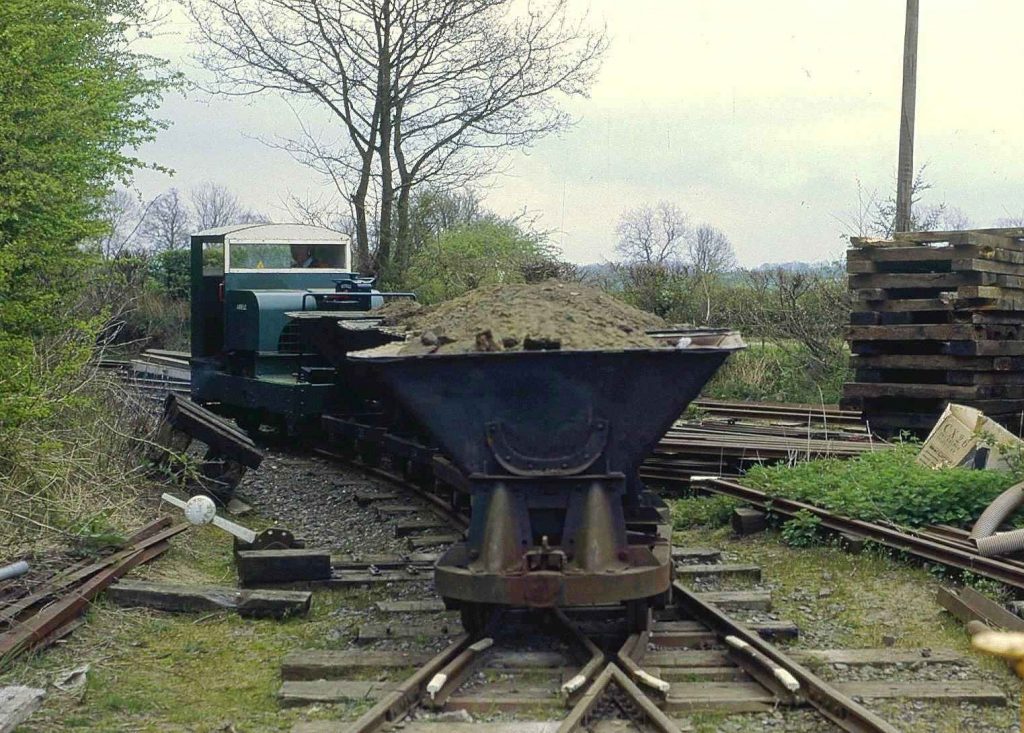
If we continue down the road past Wangels Copse the road runs parallel to the railway, down to the under-bridge leading to Charvil to the left, and right, to the Lands End public house. To the east of the latter, down to the border that is the River Loddon, was yet another gravel pit, complete with its miniature railway. Sadly by about 1960 this too was no more.
Mention has been made of Wangels Copse. Today it and the meadow to the west that stretched almost up to Denmark Road are no more. Now a school, back in the fifties and early 1960s the woods were a playground for many a young lad. Phillip clearly remembers his rudimentary cycle track that commenced in a dip to the left, just as you left the road. Conversely, if you kept going in a straight line, within seconds the area opened out as far as the railway line, where many a young lad spent a happy hour or two watching the steam trains go by.
Illustration 8. Formerly part of Ham River’s extensive gravel pits, they are now a haven for wild life in Ashenbury Park.
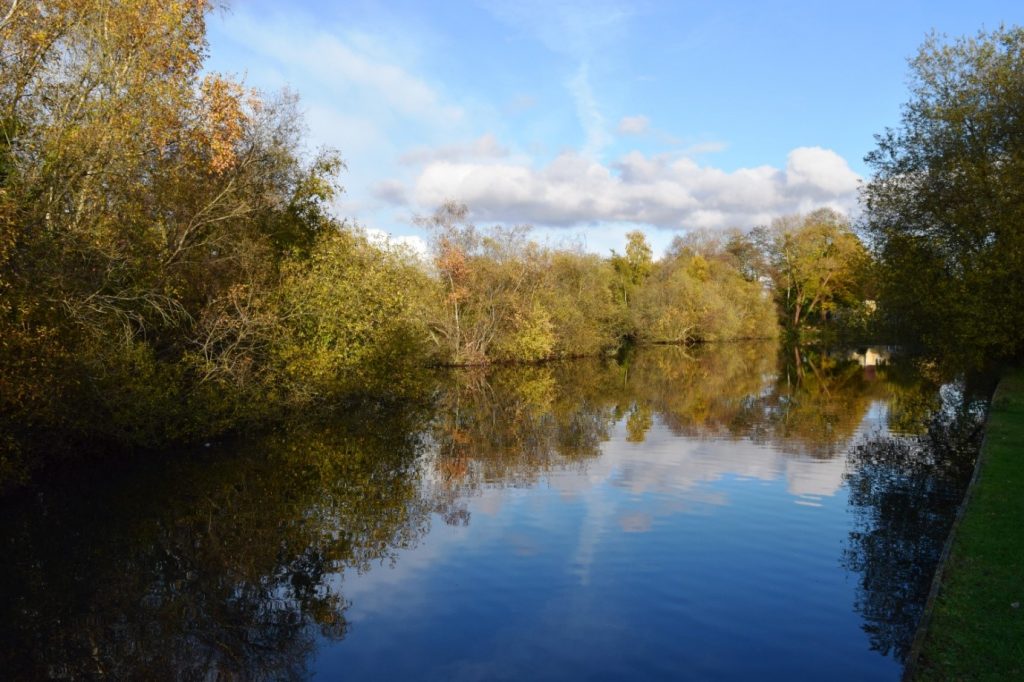
As an adult Phillip had numerous jobs that included lorry driving. So prolific were the vacancies by the late 1950s, he would happily quit of a Friday, and be back behind the wheel for another firm, the following Monday. Come the 1960s in what was another change in occupation, he was one of a gang that pulled down the Chequers public house where Woodley shopping centre now stands. Yet another role was as a heavy plant operator on bulldozers, diggers, and drag line cranes etc., as did his father.
A COUPLE OF SURVIVING VICTORIAN PROPERTIES.
Illustration 16. St Lukes Cottages, Cobblers City. Almost surrounded by modern developments, these three cottages in Headley Road East were at one time St. Luke’s Home for Sick Children. Founded in circa 1880 by Miss. Dashwood of Sonning, who also owned the property. Latterly the building became the Woodley Workingmen’s Club before conversion into private residences.
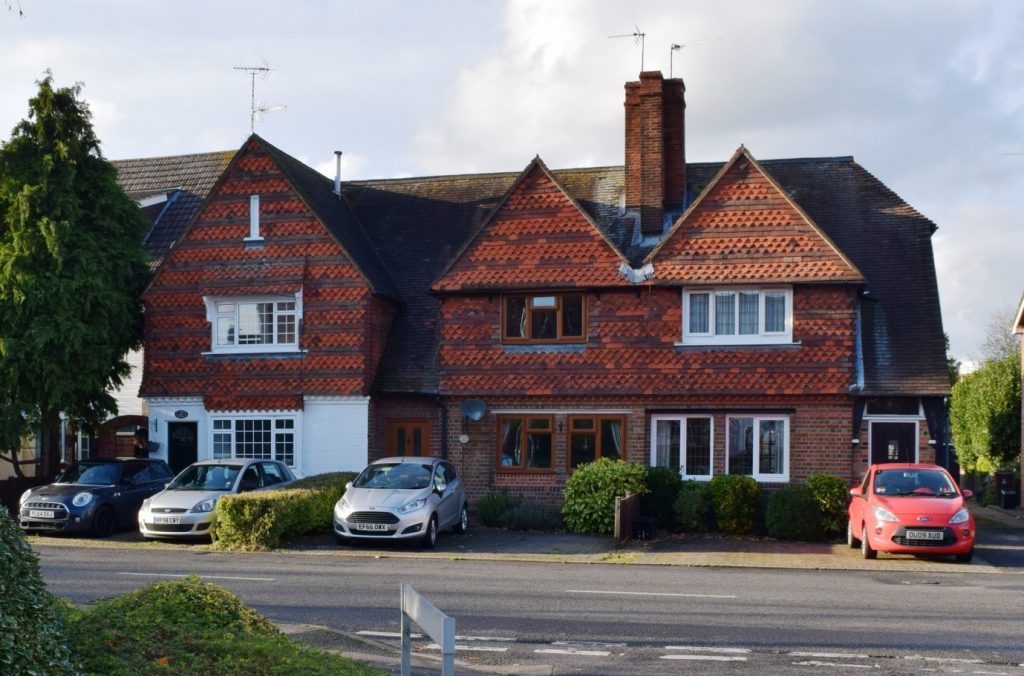
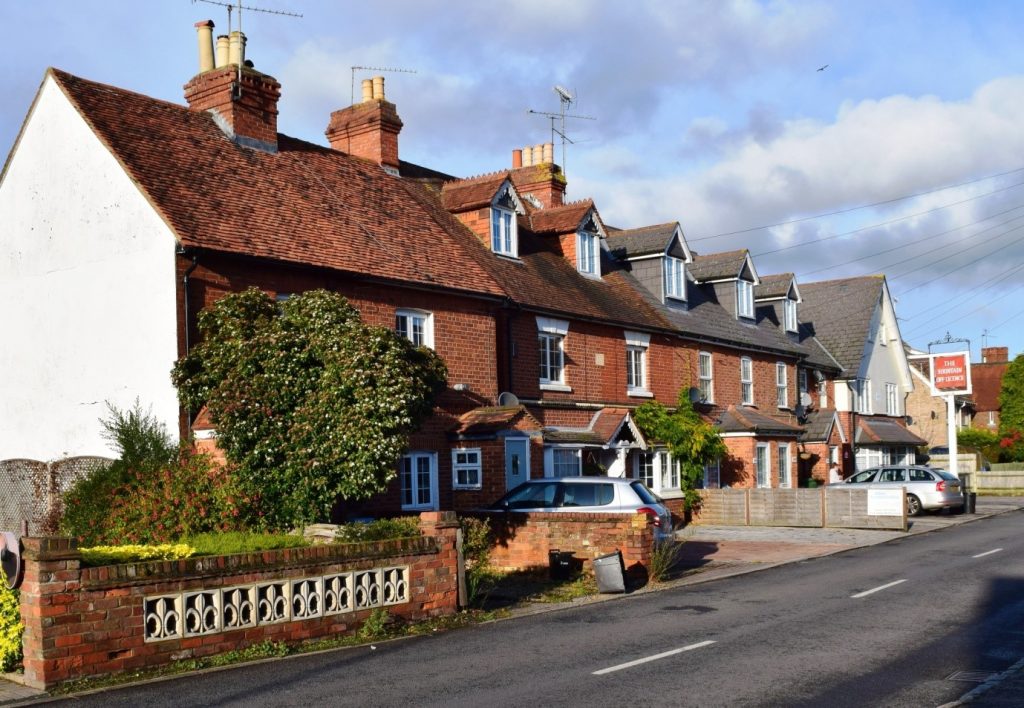
Illustration 17a. Garfield Cottages, Headley Road East. The five central houses of 1881 and the three nearby St. Luke’s examples appear to be the only surviving Victorian terraces in Woodley. Such is progress, some would say!
